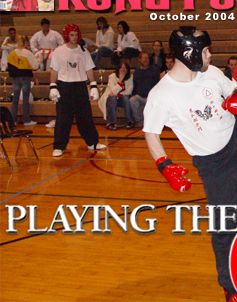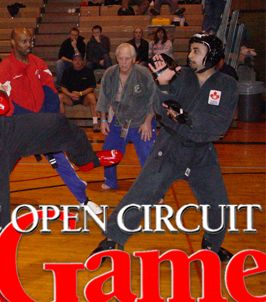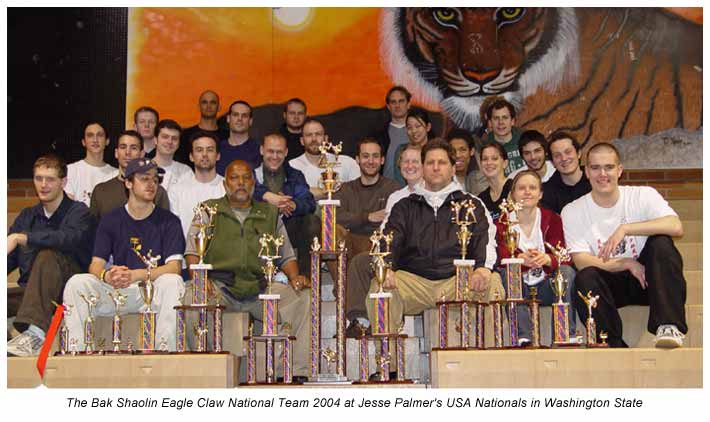




Pride. Acceptance. Stubbornness. Why would a Chinese stylist compete in open sport karate tournaments?
How about…to dispel myths.
It has long been ‘known’ on the sport karate circuit that Chinese style competitors do not fair well in forms or fighting divisions at open competitions. If that is not enough to motivate a Chinese stylist to enter and win the next possible open sport karate tournament, then what is? Perhaps it is the opportunity to compete at a greater number of top-level tournaments against a variety of challenging competitors? Perhaps for the satisfaction of rocking heads in areas that have yet to see real kung fu fighters, and will benefit from seeing the true strength of Chinese martial arts? Perhaps just for extra training?
 Tournaments provide opportunities to evolve technique, develop fighting, stoke competitive fire, and gain experience in defeating opponents strategically. Truly it is the skillful means of your martial art that brings victory at sport karate tournaments. If the purpose of attending tournaments is to further your development as a martial artist, then why limit yourself to a particular set? In fact, as Bak Shaolin Eagle Claw International has demonstrated, different types of tournaments can be used as tools to hone different techniques of fighting that, when reintegrated, evolve overall fighting ability.
Tournaments provide opportunities to evolve technique, develop fighting, stoke competitive fire, and gain experience in defeating opponents strategically. Truly it is the skillful means of your martial art that brings victory at sport karate tournaments. If the purpose of attending tournaments is to further your development as a martial artist, then why limit yourself to a particular set? In fact, as Bak Shaolin Eagle Claw International has demonstrated, different types of tournaments can be used as tools to hone different techniques of fighting that, when reintegrated, evolve overall fighting ability.
Chinese stylists arriving at a karate tournament may face hostility, derision, scorn, amusement, and curiosity from the good old boys already present. Many believe that Chinese style competitors should stay in the wushu and soft forms divisions if they even bother to show up. They think that kung fu cannot adapt their style and strategy for point sparring divisions. That their flowery, circular and gymnastic type forms are not suited for the hard style divisions. That they are not tough enough for continuous sparring divisions. Obviously, none of these martial artists have been in a Chinese style full contact sparring division, or ever stepped foot onto a lei tei.
Enter the mythbusters: Bak Shaolin Eagle Claw International.
This school of kung fu, under the direction of Grandmaster Leung Fu and national coach Sifu Dana Daniels, has been rocking the sport karate world for years. With bases in Olympia, WA, Seattle, Madison, WI, Austin, TX, Galway, Ireland, Bloomington, IN, Los Angeles and local branches all over the US, this group of hard hitting martial artists takes on all competitors in all divisions of forms and fighting. The US Bak Shaolin Eagle Claw National Team has produced top rankings in forms and fighting in both the National Blackbelt League (NBL) and the International Martial Arts Council (IMAC), as well as being a dominant force in Jesse Palmer's Northwest Martial Arts Association--the preeminent sanction in the Northwest.
Chinese stylists can and will defeat their karate counterparts in forms and fighting at open competitions, but there are obstacles to overcome in addition to the other competitors. Strategies and techniques must be adjusted, not due to effectiveness, but rather to the rules of certain leagues and locales. Even more challenging is the task of overcoming bias and ignorance in some judges.

Most Chinese stylists excel at soft forms competition, but for a student from a kung fu school to win open and hard style forms (kata) competition he or she must adapt to the division. The first step in any forms competition is choosing a form. Always go with your best form. Some circular and aerial forms do not always score well in a hard style division, as judges are looking for an overwhelming display of power, deadly strikes and accuracy. They may feel that the form is not ‘hard’ enough. Where most styles of kung fu focus on an internal energy, many hard style judges are looking for a display of external energy. Shouts and a focus on power over continuous speed will allow any good hard style judge to see past the individual’s style and recognize quality. Note that good kung fu always has power; all that is necessary is to change the flavor of demonstrating that power. Slow the pace of the form and select specific strikes and techniques to emphasize; this makes the form ‘intelligible’ to hard-style judges.
In an open and soft forms competition, Chinese stylists must be wary of the judges. An open forms division with five hard style judges is already biased against kung fu forms, and entering meekly is a waste of time for a martial artist competing with a soft style form. The best course of action is to demand that soft style judges be added to the panel. The same applies to Grand Champion divisions. Demand that tournament officials make the division ‘Open’ as it is labeled. Certainly keep an eye out for soft style divisions as well. Ensure that soft stylists are judging the division. Over time, as officials come to recognize the strength of your kung fu, there is a ‘warming effect’ wherein some biases dissolve, as your style becomes more familiar. With representatives of different styles judging the division, Bak Shaolin competitors have routinely won hard, open, and soft forms competitions with traditional forms that display true kung fu power.
 Chinese stylists will also often have forms that are larger and take more room than the kata of karate stylists. These forms are, consequently, very impressive, and provide the Chinese stylist with a chance to assert themselves onto the judges. Always inform the judges that the form will move beyond the boundaries in a firm, respectful, and take-no-shit fashion; this opportunity for exchange with the judges gives the competitor an opportunity to impress them before he even begins his form. Understanding how to turn the apparent disadvantages of difference into an advantage is the key overcoming bias and hostility.
Chinese stylists will also often have forms that are larger and take more room than the kata of karate stylists. These forms are, consequently, very impressive, and provide the Chinese stylist with a chance to assert themselves onto the judges. Always inform the judges that the form will move beyond the boundaries in a firm, respectful, and take-no-shit fashion; this opportunity for exchange with the judges gives the competitor an opportunity to impress them before he even begins his form. Understanding how to turn the apparent disadvantages of difference into an advantage is the key overcoming bias and hostility.
In point sparring competitions at open sport karate tournaments many Chinese stylists lose on points, get penalized excessively or get disqualified. Frustration sets in and eventually they decide to stick to their traditional Chinese tournaments, which reinforces the belief that Chinese stylists ‘can’t do points’.
As with the forms competitions, Chinese style competitors must adapt to their division and overcome biased judging. Top point sparring competitors in the open sport karate circuit play a good game. If their opponent does not know the rules of the game, they take full advantage. Strategy, maneuverability, range, timing and clarity of technique are the keys to point sparring. Chinese stylists, used to Chinese continuous or full-contact, often attempt to close, or bridge, the gap with their opponent and come in heavy, while a seasoned point fighter will use the opportunity to score while retreating. Continually running into front-leg sidekicks and being separated by the center judge can baffle, frustrate and enrage a fighter used to rough, continuous fighting. As in forms divisions, the key is to understand ‘the game’ of point fighting as it is played in open sport karate today.
 The first area to consider is targeting, with everything below the waist and the back as non-scoring areas, leg kicks and low techniques are of little use for scoring points. The most visible target is the head/helmet and the side of the waist between the hip-bone and the ribs. These targets are usually in full view, unlike the middle of the chest, which is obscured by the fighter’s guard and/or back. By selecting techniques that target visible areas, the techniques and points scored are made more visible. The popping sound of a glove hitting a helmet is worth more than an obstructed view of three muffled punches to the chest. A popular point fighting slogan is: “You’ve got to come out on top,” meaning that when two points are scored simultaneously, the decision usually goes to the point scored on the higher target as it is more visible.
The first area to consider is targeting, with everything below the waist and the back as non-scoring areas, leg kicks and low techniques are of little use for scoring points. The most visible target is the head/helmet and the side of the waist between the hip-bone and the ribs. These targets are usually in full view, unlike the middle of the chest, which is obscured by the fighter’s guard and/or back. By selecting techniques that target visible areas, the techniques and points scored are made more visible. The popping sound of a glove hitting a helmet is worth more than an obstructed view of three muffled punches to the chest. A popular point fighting slogan is: “You’ve got to come out on top,” meaning that when two points are scored simultaneously, the decision usually goes to the point scored on the higher target as it is more visible.
Secondly, consider that while judges might penalize a fighter for excessive contact and rough behavior for using the circular punches and qua sau that are fundamental in kung fu, there are corollary techniques that are perfectly legal. The classic example is when Bak Shaolin fighters were being penalized for circular hitting to the helmet (a legal target), it was not because the technique itself was out-of-control or excessive. It simply looked too rough and too continuous to be proper point fighting in the eyes of the judges. A quick read of their rule book will tell you that a ridgehand (under- or over-hand) is not only legal, but encouraged. Most kung fu styles have some form of ridgehand, or the qua sau can be modified to strike with the side of the hand to the helmet. Make it a crisp popping strike and the points start rolling in. Adapt kung fu techniques to the flavor of the game of point-fighting and they are forced to accept them.
 Finally, point fighters do not use that many techiniques: go to any point tournament and you will probably see 90% of all the techniques currently in play: the front leg sidekick to the waist, the double roundhouse to chest and head, the backfist (with cross), and the spinning sidekick. Where point fighters excel is their use of range, timing, and control of ring motion to execute their techniques. For a kung fu fighter used to taking a hit in exchange for getting close enough to go to work on their opponent, point fighting is a different beast that is hard to ride. The first lesson the kung fu man has to get through his head: do not charge into your opponent’s attack. The front-leg sidekick is perhaps the most-used technique in point fighting. Once you learn how to deal with that, you can start to operate in the ring. One way is to break the sidekick down. Off-lining and moving around the kick can also work. Or deliberately draw the sidekick out, and counter. The other commonly used techniques can be similarly dissected and defused, or assimilated.
Finally, point fighters do not use that many techiniques: go to any point tournament and you will probably see 90% of all the techniques currently in play: the front leg sidekick to the waist, the double roundhouse to chest and head, the backfist (with cross), and the spinning sidekick. Where point fighters excel is their use of range, timing, and control of ring motion to execute their techniques. For a kung fu fighter used to taking a hit in exchange for getting close enough to go to work on their opponent, point fighting is a different beast that is hard to ride. The first lesson the kung fu man has to get through his head: do not charge into your opponent’s attack. The front-leg sidekick is perhaps the most-used technique in point fighting. Once you learn how to deal with that, you can start to operate in the ring. One way is to break the sidekick down. Off-lining and moving around the kick can also work. Or deliberately draw the sidekick out, and counter. The other commonly used techniques can be similarly dissected and defused, or assimilated.
Continuous point fighting is generally semi-contact, which means that KOs usually result in a DQ for the kung fu competitor. Points are tallied continuously throughout the fight. Unlike Chinese continuous, which calls for an all-out, take them down approach, continuous point demands a certain rhythm. Kung fu competitors are usually warned constantly for excessive contact. So make no mistake, continuous sparring is heavier than point sparring, and, depending on the center judge and the competitors, can often get much heavier. However, it is not the semi-full contact that Chinese stylists are used to. The way their rules are set no more than three punches can be thrown without a kick or a break. The fighters who excel in this type of fighting dominate the rhythm of the fight with their own pattern of kick-1-2-3-kick-1-2-3-etc. This rhythm is present in some kung fu forms and can be adapted for use in the ring. Most Chinese stylists will have to develop past their tendency to use only hands once they close. As in point fighting, control of range so that kicks and punches are effective is a must. Once again, it comes down to adapting to your division and knowing the rules. And knowing when you are being cheated because of your kung fu uniform!
 Training for open karate competitions takes patience and diligence. A kung fu stylist cannot hope to learn all the nuances of ‘the game’ in one outing. To learn their game, you must play their game. Aside from fitness and traditional training, the competitor should identify roughly 5 techniques and 3 combos to train. These should be trained solo for clarity and form, with partners for range and targeting, as shadow-sparring for motion, and in free-sparring for application. By sticking close to a small ‘set’ of techniques, the principle of KISS is adhered to, and it pays in the ring. At first it may be difficult and frustrating, especially the sparring divisions where real life applications must be modified for legal usage in the ring. In the end Chinese stylists will benefit from competition in the open circuit. Competition encourages a martial artist to improve, learn and adapt. Although the number of traditional Chinese tournaments has increased of late, there are still relatively few opportunities to compete before top-level Chinese style masters. In the meantime, the example of Bak Shaolin Eagle Claw may stand as an example to other Chinese stylists; perhaps an influx of kung fu competitors into the sport karate circuit will lead to the next evolution of open martial arts in America.
Training for open karate competitions takes patience and diligence. A kung fu stylist cannot hope to learn all the nuances of ‘the game’ in one outing. To learn their game, you must play their game. Aside from fitness and traditional training, the competitor should identify roughly 5 techniques and 3 combos to train. These should be trained solo for clarity and form, with partners for range and targeting, as shadow-sparring for motion, and in free-sparring for application. By sticking close to a small ‘set’ of techniques, the principle of KISS is adhered to, and it pays in the ring. At first it may be difficult and frustrating, especially the sparring divisions where real life applications must be modified for legal usage in the ring. In the end Chinese stylists will benefit from competition in the open circuit. Competition encourages a martial artist to improve, learn and adapt. Although the number of traditional Chinese tournaments has increased of late, there are still relatively few opportunities to compete before top-level Chinese style masters. In the meantime, the example of Bak Shaolin Eagle Claw may stand as an example to other Chinese stylists; perhaps an influx of kung fu competitors into the sport karate circuit will lead to the next evolution of open martial arts in America.
Under the tutelage of Grandmaster Leung Fu and national coach Dana Daniels, Bak Shaolin Eagle Claw International has proven that Chinese style competitors can play the open sport karate game and win while staying true to traditional Chinese kung fu.
John Eastlake and Kevin Barrett are members of the Bak Shaolin Eagle Claw National Team. John Eastlake is a PhD Candidate and staff member at the Centre for Irish Studies, National University of Ireland, Galway. He can be reached at eastlakj@graffiti.net. Kevin Barrett is a North Carolina based martial artist and freelance writer and can be reached at kevindbarrett@yahoo.com.